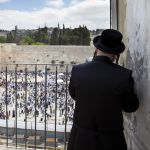“There is a time for everything…. a time to weep and a time to laugh; a time to mourn, and a time to dance.” (Ecclesiastes 3:1, 4)
In his wisdom, King Solomon wrote in Ecclesiastes that there is a season for everything, and “a time for every purpose under heaven (Ecclesiastes 3:1).”
On the Jewish calendar, Tisha B’Av, the 9th day of the Hebrew month of Av, which begins this Saturday night, is the time for mourning.
According to some rabbis, this day of fasting is as significant to the Jewish People as Yom Kippur (The Day of Atonement), which is considered the holiest day of the Jewish year.
Tisha B’Av, the saddest day in Jewish history, primarily commemorates the destruction of the First and Second Temples.
In 586 BC, Solomon’s Temple (the First Temple) was destroyed on Tisha B’Av by the Babylonians, who sent the Jews into the Babylonian exile.
Under the leadership of Nehemiah and Ezra, construction began on the Second Temple 70 years later.
In 70 CE, Herod’s Temple (the Second Temple) was destroyed on Tisha B’Av by the Romans, 656 years after the destruction of the First Temple.
This Saturday night and Sunday, religious Jews will gather to mourn the destruction of the Temples and to read the words of the Prophet Jeremiah and portions of the Book of Lamentations in synagogues around the world and at the Kotel (Wailing Wall), which is Judaism’s holiest site.
It boggles the mind to think that both Temples were destroyed on the very same day of the Hebrew calendar all those years apart.
According to the Mishna, not only were the Jewish people expelled from the land of Israel when both Temples were destroyed on Tisha B’Av, but during the time of Moses, God also delivered the verdict on Tisha B’Av that Israel wouldn’t enter the Promised Land because of their sins of unbelief, complaining, and idolatry.
Apart from Joshua and Caleb, who followed God wholeheartedly, Israel was condemned to wander in the wilderness for 40 years until the entire generation died.
Other tragic events that befell the Jewish people on this exact same day are also remembered on Tisha B’Av, most notably the expulsion of Jews from Spain.
Rabbinic oral tradition, as recorded in the Mishna (Taanit 4:6), reveals the details of several other tragedies that occurred on the 9th of Av.
Other Tragic Events That Took Place on Tisha B’Av:
In AD 132, the Romans crushed Bar Kokhba’s revolt and destroyed the city of Betar, killing over 100,000 Jews.
In AD 133, following the Roman siege of Jerusalem, the Roman commander Turnus Rufus plowed the Temple site and surrounding area.
In 1095, the First Crusade was declared by Pope Urban II, killing 10,000 Jews in its first month and annihilating Jewish communities in France and the Rhineland.
In 1290, King Edward I issued an edict expelling all Jews from England.
In 1492, an edict of expulsion of the Jews in Spain was carried out.
In 1914, World War I broke out, setting the stage for the later devastation of World War II and the Holocaust.
In 1942, on the eve of Tisha B’Av, the mass deportation of Jews from the Warsaw Ghetto to Hitler’s Treblinka death camp began.
In 1994, the bombing of the Jewish community center in Buenos Aires killed 86 and wounded 300 others.
In 2005, more than 8,500 Jewish residents were expelled from Gaza as part of Israel’s ill-fated Disengagement Plan, a desperate bid for peace designed to further relations with Palestinian Arabs.
How ironic that this time the Jewish people were expelled from their own land by secular Jewish Israelis!

In 2005, expelled residents of the Nezer Hazani community formed a protest camp in a public park in Tel Aviv. You can see people living in tents in the background.
2005 Disengagement Plan: Expelling Jews from Their Homes in Israel
The 2005 expulsion was a Land for Peace deal with the Palestinians that obviously did not bring about peace.
The Israeli government uprooted Jewish families from their homes in Gaza. A total of 1,700 families were displaced at a cost of nearly $900 million.
Daycare centers, kindergartens and schools were all closed. The Jewish bodies in the cemeteries were removed from the graves for burial elsewhere. Homes and civic buildings were bulldozed with only the synagogues left standing.
Some Israeli soldiers refused to participate, standing in their integrity before God and man, even at the risk of a military court martial.
The Disengagement Plan was an abysmal failure.
After the Jewish soldiers left Gaza, the looting began. The synagogues were desecrated and torched. Gaza became the staging ground for terrorist attacks against Israel.
And the rockets have been launched from Gaza ever since, raining terror and fear down on the Jewish towns and cities in southern Israel.
What a bitter pill to swallow!

Jewish prayer at the Western (Wailing) Wall, an ancient retaining wall for Temple Mount in Jerusalem.
On Tisha B’Av we must ask ourselves how could God’s people be brutally torn from the Land that He promised in an everlasting covenant to the descendants of Abraham, Isaac, and Jacob?
Comfort is found in Amos 9:14-15:
“I will bring back the captives of My people Israel; They shall build the waste cities and inhabit them; … I will plant them in their land, and no longer shall they be pulled up from the land I have given them, says the Lord your God.”
How can Believers, as fellow citizens in the commonwealth of Israel (Ephesians 2:12-13, 19), appropriately respond on Tisha B’Av to the grief of the Jewish people?
This is the time to weep with those who weep and to mourn with our brethren, the people of Israel.

These excavated stones from the Western (Wailing) Wall of the Temple Mount in Jerusalem were knocked down to the street below in AD 70 by Roman soldiers
Prophecy Regarding the Temple
“O Jerusalem, Jerusalem, the one who kills the prophets and stones those who are sent to her! How often I wanted to gather your children together, as a hen gathers her chicks under her wings, but you were not willing! See! Your house is left to you desolate.” (Matthew 23:37-38)
Yeshua (Jesus) foresaw the destruction of the Holy Temple and the disaster that would come upon Israel, and He wept with compassion.
He knew that not even one stone of the magnificent buildings of the Temple would remain untouched. All would be thrown down.
“I tell you the truth, not one stone here will be left on another; every one will be thrown down.” (Matthew 24:2)
Yeshua knew, too, that He was destined to fulfill the Messianic prophecies that the Messiah would be cut off before the destruction of the Second Temple (Daniel 9:26). He would pay the price for sin, but that because He was sinless, death could not hold Him. He said, “Destroy this temple, and in three days I will raise it up (John 2:19).”
The Jewish people long for and pray daily for the restoration of the Holy Temple, and in fact, today there are plans and preparations are already being made in Jerusalem for the Third Temple, although there is much opposition.
Indeed, the Brit Hadashah (New Testament) prophesies that in the end times, the Temple will be rebuilt. Within it “the man of sin, the son of perdition, who opposes and exalts himself above all that is called God or that is worshiped, … will sit in the Temple of God, showing himself that he is God.” (2 Thessalonians 2:4)
Although the Temple will be rebuilt, perhaps not long from now, the Land of Israel is still far from being the ‘Holy Land’ it is destined to be.
In Israel today, there is a great divide between those who believe in the Word of God and those who don’t.
Though circumstances may look bleak in the natural, God has not forsaken Israel.
“For Israel is not forsaken, nor Judah, by his God, the Lord of hosts, though their land was filled with sin against the Holy One of Israel.” (Jeremiah 51:5)
In the Book of Ezekiel, God sent a messenger throughout the midst of Jerusalem to “put a mark on the foreheads of those who grieve and lament over all the detestable things that are done in it.” (Ezekiel 9:4)














